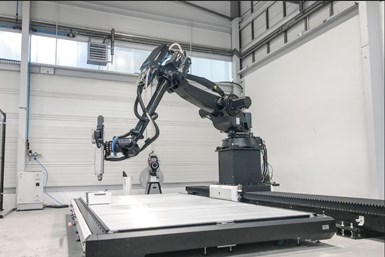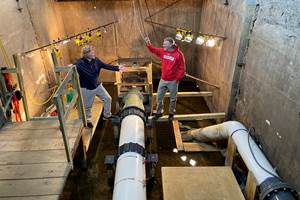AES, CEAD Collaborate on Large-Format Robotic Additive Manufacturing
Additive Engineering Solutions (AES) will receive one of CEAD’s Flexbot Robotic additive manufacturing systems to help CEAD with customer development projects and give feedback to help drive further development and innovation of the systems.
Share
Read Next
Additive Engineering Solutions (AES), a provider of large-format additive manufacturing (LFAM) polymer solutions, is partnering with CEAD (Delft, Netherlands), a manufacturer of large-scale robotic 3D printing systems. CEAD chose to collaborate with an additive manufacturing company in North America in order to advance its goals for that market.
“We knew that if we wanted to penetrate the North American market effectively, having a local, experienced partner is crucial to aid in customer development projects,” says Charléne van Wingerden, CEAD CCO.
CEAD’s business model is selling robotic AM systems, while AES sells engineering and project solutions for firms that do not have their own 3D printers. The companies say they have created a well-rounded, complementary partnership.
“Instead of CEAD performing customer project trials in Europe and shipping to the United States, we will now be able to print and showcase the technology at much more local level, all while gaining experience and knowledge on a new AM platform,” says Austin Schmidt, AES president and co-founder.
Toward the end of 2023, AES will receive one of CEAD’s Flexbot Robotic AM systems, which is designed to be modular in both size and capability, and enable upgrades and expansions to be made as needed.
“We are excited to get our Flexbot system into the hands of the talented team at AES. Not only will they help out on customer development projects but we look forward to receiving their feedback that can help drive further development and innovation of our systems,” says Lucas Janssen, CEAD CEO and co-founder. “We believe in order to be the best at what we do, we need partners to be the best at what they do, and we have that with AES.”
AES was founded in 2016 to bring the newly developed LFAM technology to the marketplace as a service. The company says it has aimed to both educate the industry on the technology’s value as well as further develop the technology and equipment in a commercial environment.
AES says it currently has the largest global capacity of LFAM-style 3D printers with four Cincinnati BAAM printers. The CEAD Flexbot system will be its first robotic AM system, enabling the company to manufacture larger and more complex structures and parts.
“We believe robotic systems with their unique capabilities, modularity and small footprint is the way the LFAM printing market is heading and we’re excited to use this new technology to expand our solutions across the tooling, full-scale mockups and part production markets,” says Andrew Bader, AES vice-president and co-founder.
AES was founded in 2016 as a contract manufacturer of large-format 3D printing services. Today, it says is has the largest global capacity of large-format 3D printing, enabling it to provide quick turn and economical solutions for the composite tooling markets, engineered and marketing mockups, and thermoplastic end-use parts.
- Read more about AES in this article about the large-format additive manufacturer moving to serial production. First tools, then production parts. This pattern with industrial 3D printing at small and mid sizes has now come to the biggest additive machines as well.
- Learn why Additive Engineering Solutions dug a pit in an additive manufacturing facility. AES moved two of its BAAM 3D printers out of the way and began to dig a hole in the floor. How going lower enables AES to build higher.
- Watch this episode of The Cool Parts Show to hear about how a flight simulator was made through large-scale 3D printing at AES. It was the show’s biggest cool part so far! Printing this massive structure in one piece saves cost and time for L3Harris.
Related Content
What is Powder Bed Fusion 3D Printing?
Whether in metal or polymer, with a laser or an electron beam, powder bed fusion (PBF) is one of the most widely used 3D printing techniques.
Read MoreHow Large-Format 3D Printing Supports Micro-Scale Hydropower
There is potential hydroelectric power that has never been unlocked because of the difficulty in capturing it. At Cadens, additive manufacturing is the key to customizing micro-scale water turbine systems to generate electricity from smaller dams and waterways.
Read MoreActivArmor Casts and Splints Are Shifting to Point-of-Care 3D Printing
ActivArmor offers individualized, 3D printed casts and splints for various diagnoses. The company is in the process of shifting to point-of-care printing and aims to promote positive healing outcomes and improved hygienics with customized support devices.
Read MoreThis Drone Bird with 3D Printed Parts Mimics a Peregrine Falcon: The Cool Parts Show #66
The Drone Bird Company has developed aircraft that mimic birds of prey to scare off problem birds. The drones feature 3D printed fuselages made by Parts on Demand from ALM materials.
Read MoreRead Next
Hybrid Additive Manufacturing Machine Tools Continue to Make Gains (Includes Video)
The hybrid machine tool is an idea that continues to advance. Two important developments of recent years expand the possibilities for this platform.
Read MoreAt General Atomics, Do Unmanned Aerial Systems Reveal the Future of Aircraft Manufacturing?
The maker of the Predator and SkyGuardian remote aircraft can implement additive manufacturing more rapidly and widely than the makers of other types of planes. The role of 3D printing in current and future UAS components hints at how far AM can go to save cost and time in aircraft production and design.
Read More3D Printing Brings Sustainability, Accessibility to Glass Manufacturing
Australian startup Maple Glass Printing has developed a process for extruding glass into artwork, lab implements and architectural elements. Along the way, the company has also found more efficient ways of recycling this material.
Read More






















